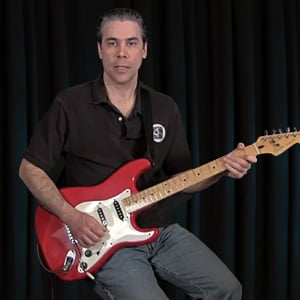Description
This tutorial is about extended harmony chords. This covers types of 11th and 13th chords. This tutorial assumes you already know & can play 7th and 9th chord forms & shapes. They can be found in these tutorials.
Introduction to Dominant 7th Chords
Introduction to Movable Dominant 7th Chords
Introduction To Major 7th Chords
Introduction To Minor 7th Chords
Practicing Major & Minor 7th Chords
This tutorial also assumes you have worked through Extended Harmony Chords Series 1 and 2.
Extended Harmony Chords Series 1
Extended Harmony Chords Series 2
We will extend the concept of triadic harmony to include the 7th, 9th, 11th and 13th of: dominant 11th, minor 11th, dominant 13th, dominant flat 13th. We will learn how to play these as chord shapes rooted on the E, A and D strings. Then we will play them in a jazzy chord progression with a backing track. While these chords can be found in other genres of music, it is most frequently jazz they are associated with.
All these chords are referred to in Music Theory as Extended Chords or Extended Harmony Chords. This is because the triadic formation process has been extended beyond the normal three notes that form basic major and minor chords. Basic major and minor chords only necessarily contain the 1st, 3rd and 5th scale degrees. In the previous tutorials we learned how to extend the chord tones to include a variety of 7th and 9th chords by leapfrogging from the fifth note of the scale, over the sixth, to include the seventh note and ninth note of the scales in the chord. Now we go further and include the 11th and 13th scale degrees as chord tones!
Lesson Info
Tutorial Lessons
- Introduction
- Dominant 11th Chords
- Using Dominant 11th Chords
- Using Dominant 11th Play Along
- Minor 11th Chords
- Using Minor 11th Chords
- Using Minor 11th Play Along
- Dominant 13th Chords
- Using Dominant 13th Chords
- Using Dominant 13th Play Along
- Dominant Flat 13th Chords
- Using Dominant Flat 13th Chords
- Using Dominant Flat 13th Play Along
- Conclusion
